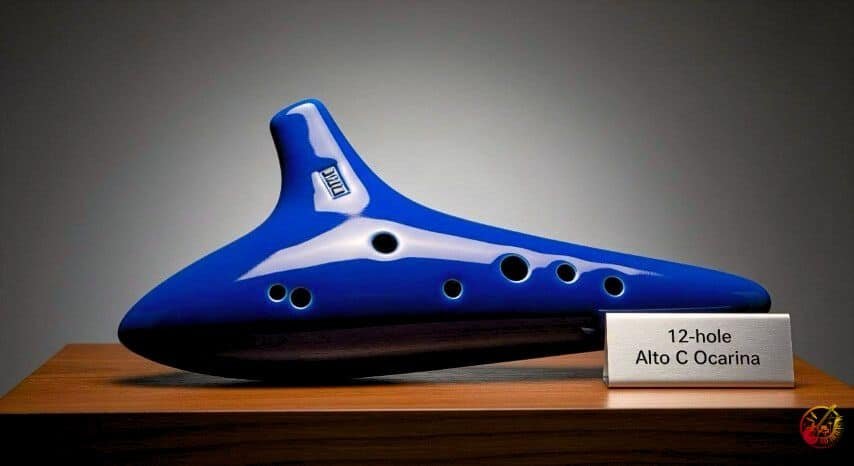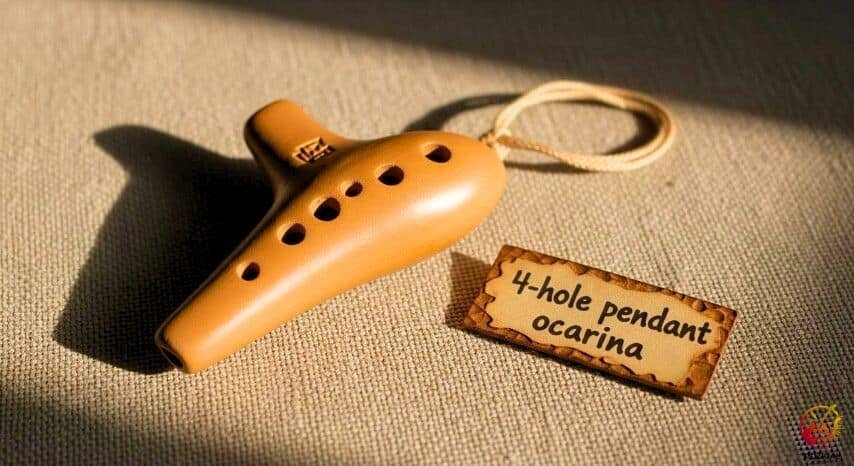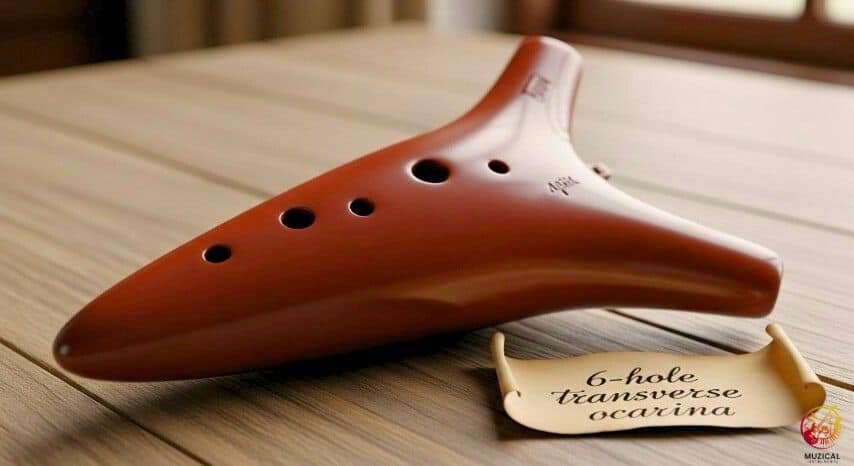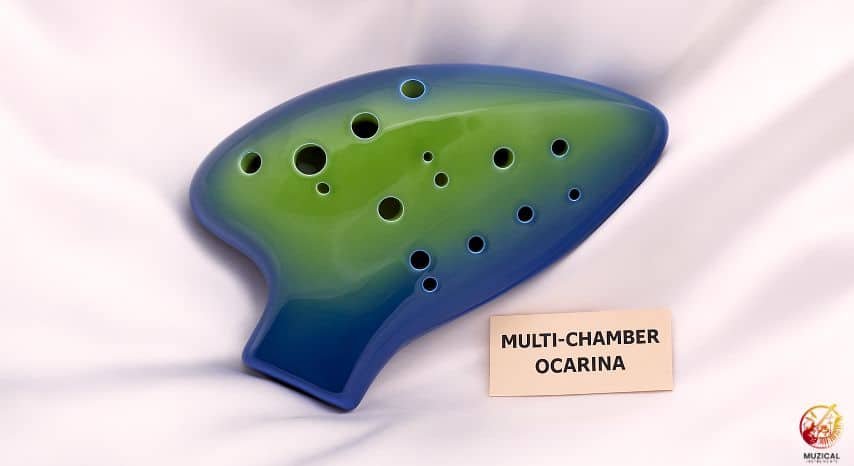How Many Holes Does a Traditional Ocarina Have?
Answering how many holes does a traditional ocarina have isn’t as simple as giving one number. While the most popular ocarina today has twelve holes, you can find models with as few as four or as many as eighteen.
The number of holes is important because it changes the instrument’s pitch range, how you play it, and the kinds of songs you can perform.
This guide will walk you through everything you need to know. We’ll look at the simple 4 hole pendants all the way up to complex multi chamber ocarinas, helping you understand which one is the right fit for your musical adventure.
So, What’s the Real Answer to How Many Holes Does a Traditional Ocarina Have?
If you ask a seasoned player, they’ll likely tell you the modern standard is the 12 hole ocarina. This is the version you’ll see most often, and it strikes a great balance between being easy to hold and having enough notes to play tons of music.

This style of ocarina, called a transverse ocarina because you hold it sideways, was perfected in the 1800s by an Italian musician named Giuseppe Donati. He turned a simple folk instrument into one that could play professionally.
The big deal with the 12-hole ocarina is that it can play a full chromatic scale. That just means you can play all the regular notes plus the sharps and flats like having both the white and black keys on a piano. This lets you play almost any song you can think of, from movie scores to folk tunes, and especially themes from video games like The Legend of Zelda, which made the ocarina famous for a new generation.
The design has ten finger holes on top and two thumb holes on the bottom. The ocarina fingering is pretty straightforward; you lift your fingers in order to go up the scale. This makes it a great starting point for beginners, but it’s also powerful enough for experts. When people want to learn the ocarina, the 12-hole model is almost always what they mean.
Are 10 Hole and 12 Hole Ocarinas Really That Different?
Looking at a 10 hole and a 12 hole ocarina side by side, you might struggle to see the difference. They have the same shape and the same ten main finger holes. So, what’s the point of the two extra holes on a 12 hole model? Those two tiny holes are called subholes, and they have one important job.
Subholes extend the ocarina’s musical range downwards. A typical 10-hole Alto C ocarina (a very common type) can play down to a low C note. The two subholes on a 12-hole let you play a B and an A below that C. It adds just two more notes, but they make a huge difference.
Why does this matter? Many songs use those lower notes. If you’re playing on a 10-hole, you’d either have to skip those notes or change the key of the entire song, which can be tricky. Think of it like a small keyboard that’s missing its last two keys on the left. You can still play a lot, but you’re limited. The good news is that the fingerings for the main notes are identical on both. If you learn on a 10-hole, you can easily switch to a 12-hole later just by learning how to use the subholes.
10-Hole vs. 12-Hole Ocarina
| Feature | 10-Hole Ocarina | 12-Hole Ocarina |
|---|---|---|
| Notes It Can Play | About 1.5 octaves (e.g., C to high F) | About 1.5 octaves + 2 low notes (A to high F) |
| Subholes | None | Two, for playing lower notes |
| Songs You Can Play | Many songs, but might miss some low notes | Almost any song that fits within its range |
| Ease of Learning | Very easy, slightly simpler for total beginners | Easy, just two extra notes to learn for full range |
| Best For | Beginners on a tight budget | Beginners and experts who want to play more music |
Can You Play Real Music on a 4, 5, or 6-Hole Ocarina?
Yes, you definitely can! Ocarinas with fewer holes are often called pendant ocarinas because they are small enough to be worn like a necklace. They might look like toys, but they are real musical instruments that can sound beautiful. These little ocarinas, which usually have four to six holes, use a different and clever fingering system.

Instead of lifting one finger for one note, you use different combinations of open and closed holes to make the notes. It’s a bit like a secret code for your fingers, and it’s surprisingly effective. A simple 4-hole ocarina can play a full scale of eight notes. The popular English pendant system for 6-hole ocarinas lets you play a full chromatic octave, meaning you get all the sharps and flats within that range.
The only real downside is the limited range. A 6-hole pendant has about one octave, while a 12-hole has over one and a half. This means you can play lots of simple melodies and folk songs perfectly, but you won’t be able to play complex music with big jumps between high and low notes.

Still, their simplicity is what makes them great. They are easy to carry, tough (especially plastic ones), and you can learn the basics very quickly.
Pro Tip: Don’t underestimate the pendant ocarina! Its simple design and clear tone are perfect for playing on the go. It’s an amazing instrument for hikers, travelers, or anyone who wants to learn a few tunes without a big commitment.
Does Having More Holes Make an Ocarina Better?
This is a common question, and the simple answer is no. When you see an ocarina with a ton of holes like 16 or more you’re not looking at a “better” ocarina, just a different kind. These are called multi-chamber ocarinas.
Think of a double ocarina as two ocarinas fused together. Each one is a separate “chamber” with its own set of holes. You play the first chamber to get the standard range of notes. Then, to play even higher notes, you move your mouth and fingers to the second chamber.

A triple ocarina adds a third chamber to go even higher. This brings us back to the question of how many holes does a traditional ocarina have; in this case, there are many, but they are split across different sections.
These instruments are amazing for professional players who need a huge three-octave range for difficult music. But they are also much harder to play and more expensive. You have to learn how to switch between the chambers smoothly, which takes a lot of practice with your breath pressure.
The quality of an ocarina comes from how well it’s made, not how many holes it has. A well tuned ceramic ocarina with just 6 holes can sound much more beautiful than a cheap, out of tune triple ocarina. For most people, the range of a standard 12-hole is more than enough to play thousands of songs.
How Do All These Holes Actually Work?
Understanding how an ocarina makes sound is pretty cool. It’s not like a flute, where the length of the tube changes the note. An ocarina is a vessel flute, which works more like blowing across the top of a glass bottle.
The pitch of the sound you hear depends on the volume of air inside and the size of the opening. When you blow into the ocarina’s mouthpiece (the windway), the air hits a sharp edge that makes the air inside the main chamber vibrate. That vibration is the sound you hear.
When all the finger holes are covered, the opening is small, and you get the lowest note. Every time you lift a finger, you make the total opening bigger. A bigger opening makes the air vibrate faster, which creates a higher pitch. It’s a delicate system. You also have to change your breath blowing gently for low notes and more strongly for high notes to keep them in tune.
This control over your breath is one of the key skills you’ll learn as a player. The question of how many holes does a traditional ocarina have is directly related to how many different pitches the instrument is designed to create.
What the Holes Do on a 12-Hole Ocarina
| Hole Group | Your Fingers | Their Main Job |
|---|---|---|
| Left Hand (Top) | Four Fingers | Plays the highest notes of the scale. |
| Right Hand (Top) | Three Fingers | Plays the notes in the middle and lower part of the scale. |
| Subholes (Right Hand) | Two Fingers | These are special holes that play the two extra-low notes. |
| Thumb Holes (Bottom) | Left & Right Thumbs | These two holes are part of the main scale, usually for low notes. |
Final Thoughts
So, how many holes does a traditional ocarina have? The most common answer is twelve, and that’s the model that gives you the most freedom to play all kinds of music.
But as we’ve learned, ocarinas with 4, 6, 10, or even more holes are also part of the family, each offering something different.
The important thing to remember is that more holes don’t automatically mean a better instrument, they just mean more notes. A great sound comes from good craftsmanship.
For anyone wanting to start, we highly recommend a 12-hole Alto C ocarina. It’s the best all around choice and has the most tutorials and songbooks available.
Learning about how many holes does a traditional ocarina have is the first step. The next is to pick one up and start playing. Which musical journey will you begin?
FAQ: How Many Holes Does a Traditional Ocarina Have?
1. What is the best ocarina for a beginner?
For most people starting out, the best choice is a 12-hole Alto C ocarina. This type gives you a wide range of notes to play most songs, and there are tons of free tutorials, fingering charts, and songbooks available for it. If you’re on a budget or buying for a child, a plastic one is a great, durable option. If you want a more beautiful sound, consider a ceramic one.
2. Can you play any song on a 12-hole ocarina?
You can play a huge number of songs! A 12-hole ocarina has a range of about an octave and a half (13 notes), which is enough for the melody of most pop songs, folk tunes, and video game themes. You might only run into trouble with songs that have very large jumps between super low and super high notes, but for the most part, a 12-hole ocarina has you covered.
3. Is it hard to learn the ocarina?
The ocarina is considered one of the easier instruments to pick up. The basic fingerings are simple, and you can learn to play your first simple songs within a week or two with a little practice. The trickiest part is learning good breath control, blowing softer for low notes and stronger for high notes to make sure they sound clear and in tune.
4. What’s the difference between a ceramic and a plastic ocarina?
The main differences are sound, durability, and cost.
Plastic ocarinas are very tough, affordable, and perfect for travel or for young players. They can sound surprisingly good.
Ceramic ocarinas are more traditional and are known for having a richer, more resonant sound. However, they are more fragile and usually cost more.
5. Why does the ocarina from The Legend of Zelda look different?
The famous blue “Ocarina of Time” is based on a real style called a pendant ocarina. These are smaller, often have 4 to 7 holes, and use a different fingering system than the 12-hole transverse models. They are completely real instruments known for their sweet, pure tone, which was perfect for the melodies in the game!
